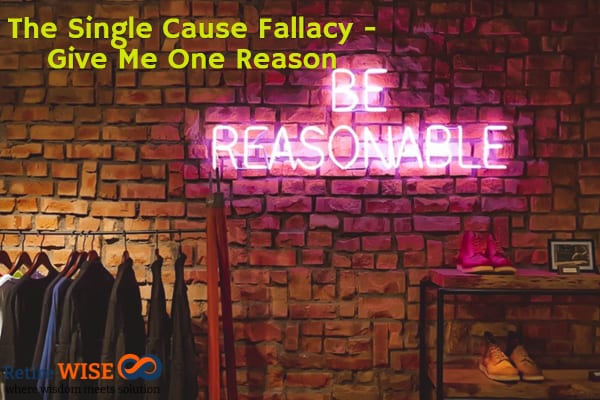In the U.S, a survey showed that the life expectancy of the average American male was lesser than that of a male in Sweden or Japan.
Different people had different theories on this.
One theory attributed the lower life expectancy to the pressure of business performance. Another theory said it was the faulty diet and a third suggested that poor medical practices led to this.
Attributing the lower life expectancy to just one cause is an oversimplification.

Single Cause
Usually, there is a range of causes for one effect. We like pointing to one cause and making it the sole reason for some event as we feel we can fix this one cause and solve the problem.
But this is simplifying the problem too much.
Oversimplification can lead to distortion of facts and even wrong decision making. It will also hinder problem-solving techniques as there will be concentration on the ‘One Cause’ when in fact there might be different facets to the problem.
Question for You
If a car manufacturer slashes the price of a model by Rs. 1,00,000, will sales reach an all-time high?
People might initially think of buying that model but there are many other factors that lead to a purchase of a car – price, brand, neighbour’s car etc.
Maybe the sale will increase due to the discount but it will not be the sole reason for one to buy the car in most cases.

Single Cause Fallacy in Investments
Similarly in the investment world or financial planning area, it might be unwise to attribute an event to one cause only. We like to simplify things and therefore try to attribute an event or effect to one incident or announcement or cause.
If an economic event has taken place like a fall in the stock prices or a surge in real estate prices, it should be analysed in the following manner to truly understand the event, its causes and consequences –
1) Understand the event – You should understand it by asking these questions –
- What is it? – What has happened exactly?
- Why did it happen? – What are the factors that caused the event?
- What will happen next? – What are the consequences of this event and how will I get affected by it.
2) Analyse the factors that caused the event.
3) Understand the consequences of the event and how it will affect you
4) Decide whether you have to take some action and the best action to take so that your objectives are fulfilled.
Read – The Art of Thinking Clearly in Finance
One Reason – Not Enough
In case of investments and personal finance, many of us try to find one reason to base our decisions upon. But it is never that simple. Let us look at some examples –
Higher Risks for Higher Returns
We often hear that higher risks lead to higher returns. Does that mean you invest all your money in a risky asset?
Of course not! When they say higher risks lead to higher returns, it means there is potential for higher returns. It does not mean you can invest all your money in one stock or one mutual fund scheme today and expect fantastic returns one year down the line.
There are many factors that have to be considered –
- Your Risk Profile
- May be valuations
- What about your Goals
- Asset Allocation or Exit Strategy
- Many more etc.

SIP is the best way to build wealth
Systematic Investment Planning(SIP) is the regular investment of a small amount commonly used as an investment strategy in a mutual fund scheme. This can be done in many asset investments.
It is a great way of regular investments and building wealth. But you cannot conclude that ‘SIP investments can build great wealth’.
For example an investor invests Rs. 10,000 in January and gets 1000 units of an MF scheme. The markets are on a rising trend and he keeps investing Rs. 10,000 on a monthly basis. Each month he will get fewer units. Now suppose there is a crash at the end of the year or 3 yrs and he need to sell his investments, he will be disappointed as he will get lower returns.
SIP investments are good but at the same time you to look at other things. Factors such as horizon, volatility, type of investment, investment goals are also factors that affect the wealth building process.
For example, SIP investments do better when there is volatility in the market. They are good for long term goals such as retirement. If you are investing to generate money to build a house 2 years down the line, you should probably invest keep most of your savings in liquid fund.
Read – How Hindsight Bias Impact our Decision Making
Financial Markets are Complex
Investment strategy and financial markets are complex subjects. Usually events never occur due to a single reason. A multitude of factors affect them and a whole set of other factors affect our personal finances.
Media is badly suffering with Single Cause Fallacy
It is better to understand that a single fix cannot solve all issues and regular review and steps to optimise the investment portfolio will help us in getting better returns and building wealth.
Hope you learned something new. Please share your experiences in the comment section on single cause fallacy.
well-written message!
Great message
Nice Post! thanks for sharing this Post.
Great Article Sir
Great post! Thanks for sharing this amazing post.
This post is really great
Thanks for appreciating 🙂
I have always admired your site, Thanks for the great tips and work .
Thanks for appreciating 🙂
Comments are closed.